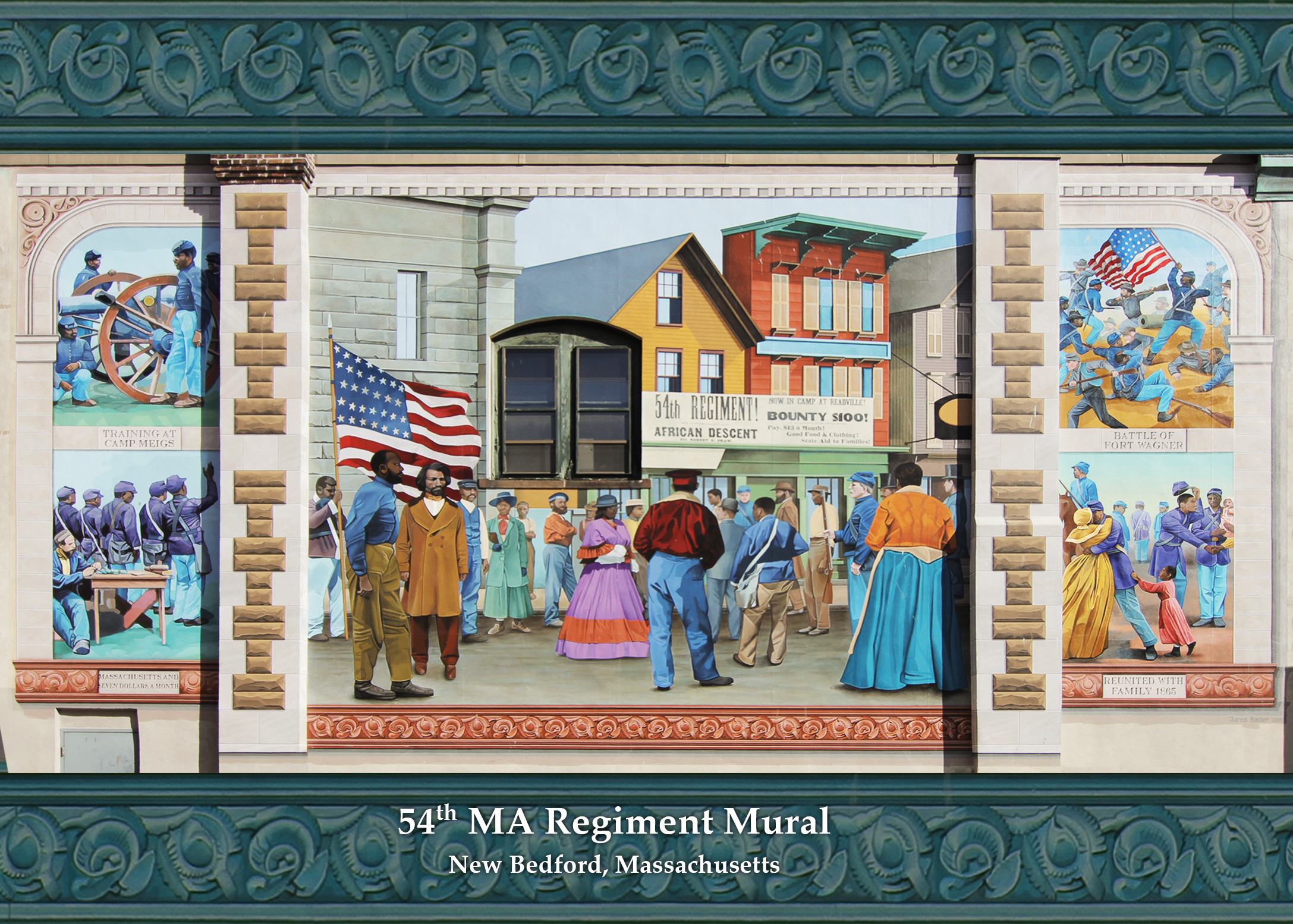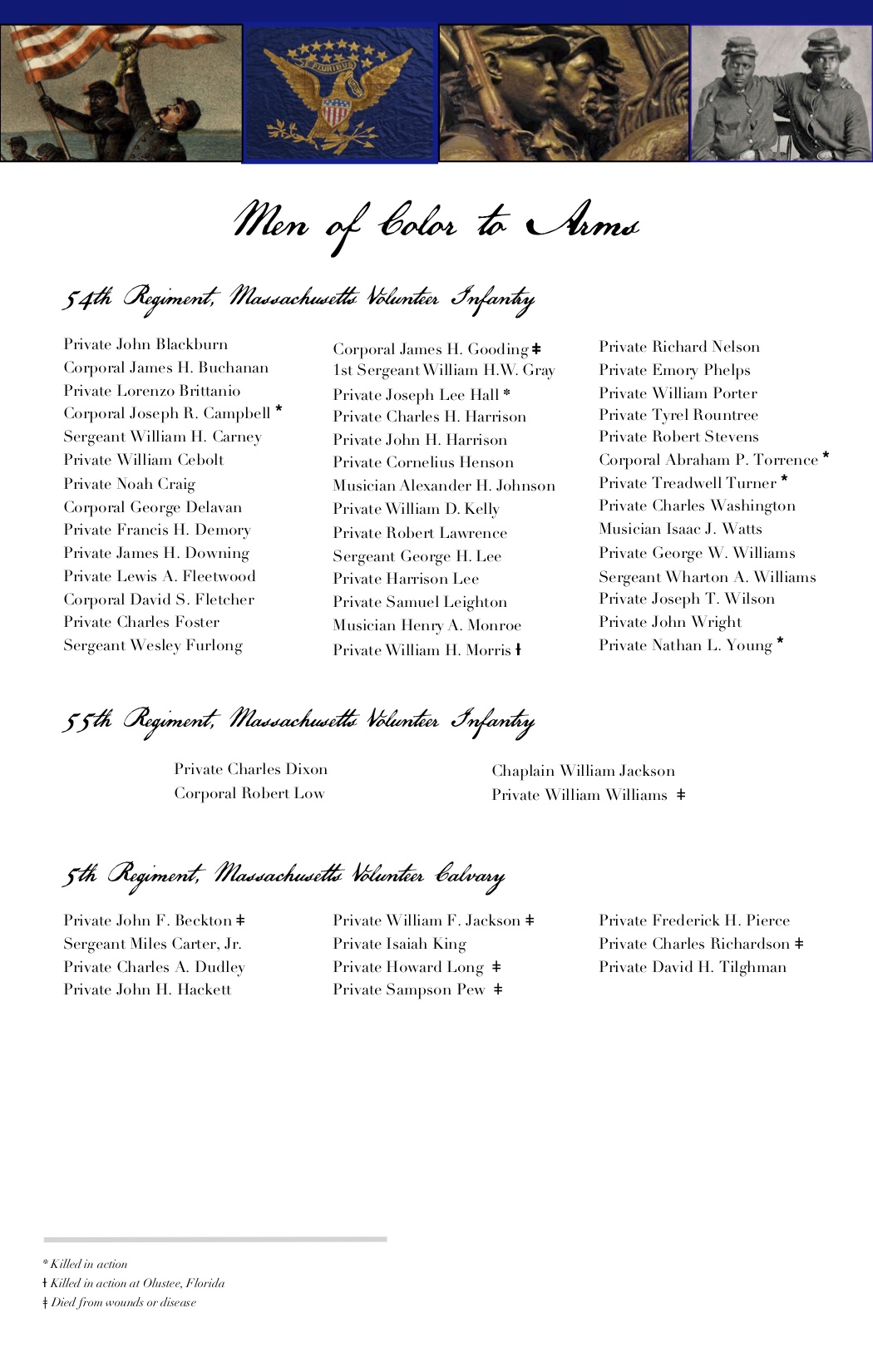
Fifty-Fourth Massachusetts Volunteer Infantry Regiment Mural dedicated July 18th, 2015
The Fifty-fourth Massachusetts Volunteer Infantry Regiment was the first military unit consisting of Black soldiers to be raised in the North during the Civil War. Prior to 1863, no concerted effort was made to recruit Black troops as Union soldiers. The adoption of the Emancipation Proclamation in December of 1862 provided the impetus for the use of free Black men as soldiers and, at a time when state governors were responsible for the raising of regiments for federal service. Massachusetts was the first to respond with the formation of the Fifty-fourth Regiment.
The formation of the regiment was a matter of controversy and public attention from its inception. Questions were raised as to the Black man’s ability to fight in the “white man’s war.” Although Massachusetts governor John A. Andrew believed that Black men were capable of leadership, others felt that commissioning blacks as officers was simply too controversial; Andrew needed all the support he could get. The commissioned officers, then, were white and the enlisted men Black. Any Black officers up to the rank of lieutenant were non-commissioned and reached their positions by moving up through the ranks. On 28 May 1863, upon the presentation of the unit’s colors by the governor and a parade through the streets of Boston, spectators lined the streets with the hopes of viewing this experimental unit. The regiment then departed Boston on the transport De Molay for the coast of South Carolina.
On February 12, 1863, forty-six New Bedford residents answered the call to serve their country and fight against slavery. The recruiting office was located just west of the U.S. Customs House where many prominent abolitionist figures including Frederick Douglass, James Bunker Congdon, Wendell Phillips and others promoted its efforts.
Leading the attack on Fort Wagner, near Charleston, South Carolina, on July 18, 1853, the men of the 54th Regiment proved themselves worthy of the hopes of their supporters. During the battle Sgt. William H. Carney of New Bedford took the United States flag from the fallen standard bearer and carried it under fire to the Confederate parapet. Despite several wounds, he returned the colors safely to Union lines, handing them over with the words: “The old flag never touched the ground, boys.”
The battle itself was considered a temporary defeat for the Union, but was a turning point for the country. The valiance of the 54th Regiment challenged many that questioned whether African-American soldiers had the courage, fortitude, and discipline to be committed soldiers. News of their actions gained more supporters for the case of racial equality and equal pay for all soldiers. Sergeant Carney became the first Black man to earn the Metal of Honor.
About the Muralist, Jared Bader
Jared earned a B.F.A. from Tyler School of Art, Philadelphia, PA and an M.F.A. from Memphis College of Art, Memphis, TN. His career in public art and mural making started in 2002 with the Philadelphia Mural Arts Program when he began assisting other artists on several mural projects. In 2004 he began his own murals for the Mural Arts Program. He has painted a number of murals throughout Philadelphia and New Jersey. Jared was chosen by the AIR partners after a national call for artists.
Unveiling the Mural for the 54th Regiment
It took three years for the Society and its partners to raise the funding to commission the new mural downtown celebrating the 54th MA Regiment, the first African-American regiment of the Civil War. You can find this great example of public art on the entire side wall of the Freestone’s City Grill on William Street. This summer we celebrated the project that honors the 54th Regiment Massachusetts Volunteer Infantry.
The guest of honor and keynote speaker was former National Park Service Director Robert Stanton, the first African-American to head the agency. He urged his audience to ask themselves, “What am I doing to foster justice, equality and dignity?”
Stanton served for almost four decades and is known for increasing national recognition of properties and programs created by minority populations within the National Park Service. He emphasized the importance of the mural and noted that “Our youth are raised by the environment we build for them”. Each organization partner of the project spoke along with MA. Rep. William Keating, Mayor Jon Mitchell and Councillor Dana Rebeiro.
Members of the Cape Verdean Veterans Association and Civil War reenactors from Boston also joined the ceremony on the same corner where volunteer soldiers would have enlisted over 150- years ago. This type of tribute, like the mural itself, grants us a glimpse of history that is accessible for everyone. The mural depicts the regime’s recruiting days during the Civil War, the support of the citizens at the time and the men committed to fight for their rights within a still segregated army. New Bedford sent one of the largest contingents of recruits to the 54th Regiment.
Many guests were awed by the transformation of the Freestone’s pocket parking lot which, originally beige, is now a vibrant scene that caused more than a few cars to pull over. Our compliments to artist Jared Bader, who successfully captured the regiment’s decisive actions and sacrifices that paved the way for equal rights.
The Artist-in-Residence Partners for the New Bedford Mural Project included:
New Bedford Historical Society
New Bedford Art Museum/Arts Works!
New Bedford Civil War Roundtable
New Bedford Cultural Council
New Bedford Whaling National Historical Park
UMD College of Visual and Performing Arts
The Whaling History Alliance




